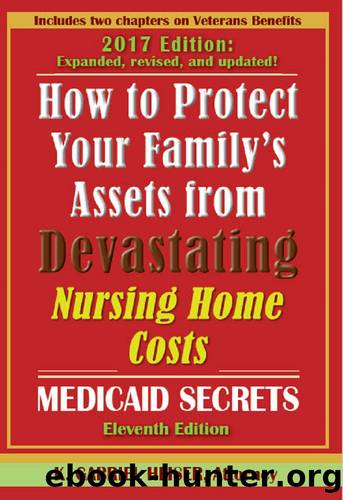How to Protect Your Family's Assets from Devastating Nursing Home Costs: Medicaid Secrets (11th ed.) by Heiser K. Gabriel & Heiser K. Gabriel

Author:Heiser, K. Gabriel & Heiser, K. Gabriel
Language: eng
Format: epub
Publisher: Phylius Press
Published: 2016-12-30T16:00:00+00:00
Normal Life Expectancy
If John must turn over every annuity payment to the nursing home, and if the payments must stop upon John’s death, at first blush it appears that there is no benefit to this type of annuity: at John’s death, the annuity payments stop, and no part of the money ever gets to his other family members. However, it may still make sense to purchase an annuity in this case: see discussion at top of see here.
Shorter-Than-Normal Life Expectancy
If John’s annuity had a guarantee period equal to his life expectancy of 17.7 years, and John dies after, say, five years, the annuity does not stop at his death but must continue for the remainder of the guarantee period, i.e., 12.7 more years. Assume that the monthly payments will be $492 per month.
So if John invested $100,000 in the annuity and turned over every payment he received to the nursing home ($492 per month x 60 months), and he died after five years, his family will receive the balance of the monthly payments for the next 12.7 years: $492 x 12 months x 12.7 years = $74,981.
(NOTE: In most cases the family cannot terminate the annuity and cash it in; they must simply wait and receive each annuity payment according to the same payment schedule that was in effect while John was alive. There are only a few companies that will allow the beneficiaries to cash out; if that is something John wants, then he will have to accept slightly reduced monthly payments in exchange for this option.)
However, if John had qualified for Medicaid coverage, upon his death the annuity payments must go to the state, up to the amount of Medicaid payments it made on John’s behalf. So the benefit to his family would have to be reduced accordingly.
If the state must be paid back, does it still make sense to purchase an annuity? It might, if certain conditions exist. By qualifying the annuity owner for Medicaid, the payments to the nursing home are reduced. This “stretches out” the benefit of the annuity and reduces the amount of total cost to the family.
Example:
With Estate Recovery Against a Home
John, age 65, invests $100,000 in an annuity that will pay him $492 per month for the rest of his life, with a guarantee period equal to his life expectancy of 17.7 years. His only other income is Social Security of $925 per month. He has a personal needs allowance (PNA) of $35/month, leaving him an $890 patient pay amount (the amount that goes to the nursing home each month). Each month both this patient pay amount and annuity payment must be turned over to the nursing home; Medicaid pays the balance of the bill. If the “Medicaid reimbursement rate” for John’s nursing home is $3,500 per month, then each month the state pays the nursing home $3,500 – $890 – $492 = $2,118. If John dies after five years, the state will have paid out a total of $127,080 for his care (60 months x $2,118 = $127,080).
Download
This site does not store any files on its server. We only index and link to content provided by other sites. Please contact the content providers to delete copyright contents if any and email us, we'll remove relevant links or contents immediately.
Good by S. Walden(2915)
The Social Psychology of Inequality by Unknown(2311)
0041152001443424520 .pdf by Unknown(2220)
The Checklist Manifesto by Atul Gawande(2204)
The Meaning of the Library by unknow(2069)
23:27 by H. L. Roberts(1893)
Guns, Germs and Steel by Diamond Jared(1885)
Being Mortal: Medicine and What Matters in the End by Atul Gawande(1805)
Borders by unknow(1786)
A Leg to Stand On by Oliver Sacks(1713)
The Hot Zone by Richard Preston(1632)
And the Band Played On by Randy Shilts(1615)
The Valachi Papers by Peter Maas(1516)
The Obesity Epidemic by Robyn Toomath(1421)
The Laws of Medicine by Siddhartha Mukherjee(1416)
The Andromeda Strain by Michael Crichton(1367)
The Plague and I by Betty Macdonald(1268)
Pharmacy Practice and The Law by Richard Abood(1254)
Autism's False Prophets by Paul A. Offit(1238)
